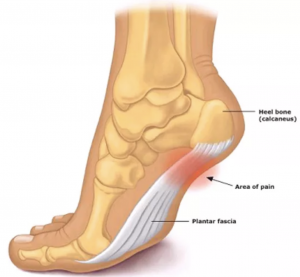- Home
- PBMt/LLLT
- Conditions
- FAQ/Costs
- Cases
- Media
- References
- Contact Us
- Meet the Doctor
- Dr Parmar’s Blog
- Home
- PBMt/LLLT
- Conditions
- FAQ/Costs
- Cases
- Media
- References
- Contact Us
- Meet the Doctor
- Dr Parmar’s Blog
(03) 8529 2225
Plantar Fasciitis also known as “heel spur” can be successfully treated with LLLT to achieve resolution.
To view cost of treatment click here.
GP, Dr Shikha Parmar,
has a special interest in providing a drug-free safe, effective treatment solution in Melbourne for acute injuries and chronic pain using low level laser light therapy (laser therapeutics).
Causes
The plantar fascia is a thick, strong, fibrous band of tissue made up of collagen fibres. It runs along the bottom of the foot connecting the heel to the base of the toes.
Plantar fasciitis is an overuse injury. being the result of many micro-tears to the plantar fascia that have happened over time.
It can occur when there is overloading of the plantar fascia due to excessive repetitive strain or exercise
with increased training volume, or sometime just from an increase in daily activities.
Common causes include: over-training, unaccustomed use – “too much too soon” e.g. embarking on walking for fitness, sudden change in training surface e.g. grass to bitumen, or poorly supportive, unsuitable or worn footwear.
Being flat-footed itself does not cause plantar fasciitis and does not prevent effective recovery from it.
The injury consists of micro-trauma or small tears in the plantar fascia where it attaches to the heel and along its course. Inflammation is the body’s immune response attempting to heal the injury.
Symptoms
Plantar fasciitis frequently, causes pain first thing in the morning after sleeping, or after long periods of sitting or standing. The pain initially gets less during activity but then worsens as activity continues.
While plantar fasciitis frequently is noticed under the heel, it may extend along the entire course of the fascia to involve the edges of the heel or the arch of the foot.
Diagnosis
A diagnosis is usually able to be made based on the history and a physical examination
The heel and arch will be tender to touch and may appear swollen. An ultrasound may also be performed to demonstrate inflammation of the plantar fascia. The presence of a heel spur or bony prominence often accompanies plantar fascia inflammation and is not the direct cause of symptoms experienced and does not preclude or prevent recovery from plantar fasciitis.
Treatment
LLLT HELPS WHERE ORTHOTICS, TAPING, ICING, ROLLING OVER A BALL, STRETCHING, MASSAGE, ANTI-INFLAMMATORY MEDICINES INCLUDING INJECTIONS AND SHOCKWAVE THERAPY MAY NOT
Traditionally, treatments for Plantar Fasciitis consist of temporary pain relief using anti-inflammatory medication, rest, and icing the area. While ice numbs the pain it also prevents healthy blood flow which is essential to providing oxygen and nutrients to the area to heal it, and remove waste products and CO2. Ice should therefore not be applied to chronic injuries such as plantar fasciitis. Repeated icing of plantar fasciitis therefore may actually be a reason for non-healing. Also see here
A number of other treatments are described in the literature e.g. massage, stretching, rolling a massage ball with vigour under the heel. These measures are often painful to the sufferer and none of these definitely heal the tissues. Stretching an injured plantar fascia further stresses the micro-tears in the substance of this fascial collagen band. Stretching is often painful to perform and does not assist in the tissue’s attempt to repair the small tears.
It is not possible to heal damaged soft tissues through strengthening exercises. The injured tissue needs to heal and exercise does not promote healing of the injured plantar fascia.
Anti-inflammatory medications including cortisone (steroid) injections do not heal tissues and simply act by masking pain. Any anti-inflammatory effect of such medication has the detrimental effect of suppressing the body’s own natural immune healing response. In addition, use even beyond a week of oral anti-inflammatory medication is associated with a number of problematic side-effects and evidence indicates these medications in fact can delay tissue healing.
At Laser Pain Therapy we utilise Low Level Laser Therapy (LLLT) at the centre of our holistic treatment approach to non-healing plantar fascia. LLLT combined with appropriate self-care, which we advise our patients of in detail through our treatment protocol, is an effective, painless, non-invasive treatment option for Plantar Fasciitis. This treatment is backed by over 40 years of scientific research and clinical evidence. LLLT removes the obstacles to healing, being inflammation, and stimulates the body’s own healing processes thereby promoting tissue healing. Read in detail here how LLLT undertaken as part of a therapeutic treatment plan at Laser Pain Therapy can resolve Plantar Fasciitis, effectively and affordably.
To see how Low Level Laser Therapy can help your condition contact us for more information or to make an appointment. And read our Reviews on Google here!